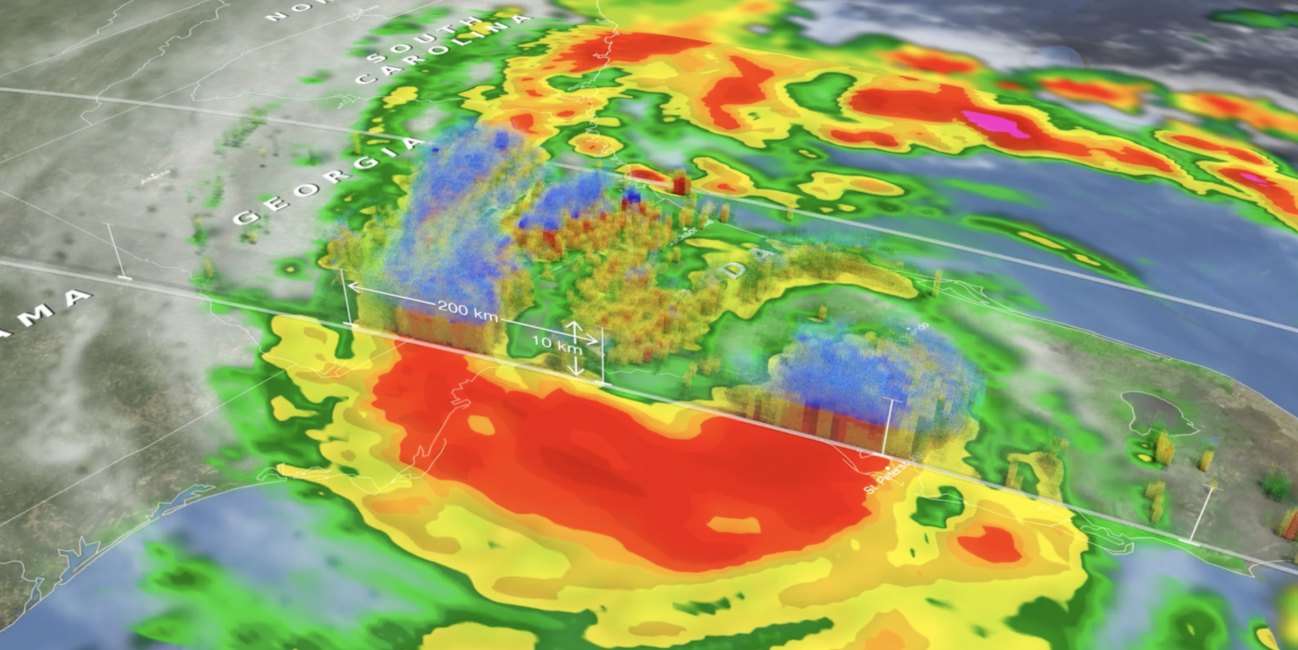
Nicole Brings Heavy Rain to Florida and parts of the Southeast
Hurricane Nicole hit the East Coast of Florida early yesterday morning, November 10th, 2022, at 3:00 am (EST) just south of Vero Beach at North Hutchinson Island. But, unlike Hurricane Ian which came ashore in late September as a powerful Category 4 storm that devasted parts of southwest Florida, Nicole made landfall as minimal Category 1 storm. Though far less intense, Nicole has still brought some heavy rain and gusty winds to the region.
Nicole originated from a non-tropical low pressure system over the southwestern Atlantic. As a result, when the National Hurricane Center (NHC) was first able to identify a rather well-defined center at 4:00 am EST on the morning of the 7th, the low-level circulation was fairly broad with the strongest winds well away from the center, so the system was named Subtropical Storm Nicole. At this time, the center was located about 555 miles due east of the northwestern Bahamas with initial movement was towards the northwest. Nicole maintained its subtropical storm structure throughout the 7th, but by the morning of the 8th, deep convective storms had emerged near the center, suggesting that Nicole was poised to intensify and had transitioned from subtropical to tropical. As a result, Nicole was renamed as a tropical storm by NHC at 10:00 am EST on the 8th. The system also took on a westward track as a deep layer ridge of high pressure north of Nicole shunted the system back towards Florida. Nicole slowly but steadily intensified throughout the day with maximum sustained winds increasing to 70 mph, nearly hurricane strength; however, further intensification ceased as NHC reported that evening that dry air was likely inhibiting thunderstorm development near the center.
Download this video in high resolution from the NASA Goddard Scientific Visualization Studio
The combination of NASA’s IMERG precipitation product and the GPM Core Observatory satellite with its array of active and passive sensors is ideal for monitoring and studying tropical cyclones, including hurricanes. The above animation shows Nicole as it passes through the Bahamas and into central Florida. The first part of the animation shows a time loop of IMERG surface rainfall estimates beginning at 16:11 UTC (11:11 am EST) on 9 November when Nicole was nearing Great Abaco Island in the Bahamas. At the start, IMERG shows that Nicole’s precipitation field is attached to the southwestern end of a long quasi-linear band of precipitation associated with a midlatitude frontal system extending well out into the central and northern Atlantic. IMERG also shows that most of the precipitation, including the moderate and heavy rain (shown in orange and red, respectively), associated with Nicole is fairly well north and west of the center. However, enough convective storms had formed near the center as evidenced by areas of moderate to occasionally heavy areas of rain wrapping nearer to the center around the southeast side of the storm, that Nicole was able to reach hurricane strength at 6:00 pm EST (23:00 UTC) while making landfall on Grand Bahama Island. IMERG shows Nicole continuing on to make landfall on Florida’s east coast on the morning of the 10th and continuing on across the peninsula. By the end of the loop at 16:21 UTC (11:21 am EST) on the 10th, after the center had crossed most of central Florida, heavier rain bands are located over western and northern Florida and southeastern Georgia.
It was around this time that the GPM Core Observatory flew over the center of Nicole. The second part of the animation shows a detailed look into the structure and intensity of the precipitation within Nicole from the GPM Core Observatory around 16:30 UTC (11:30 am EST) on the 10th of November. Surface rainfall estimates from the GPM Microwave Imager (GMI) show Nicole is very asymmetric with a heavy rainband (shown in red) out over the northeast Gulf of Mexico west of the center extending northward up across the central Florida panhandle, back across southeast Georgia, and into coastal South Carolina with very little rain evident south and east of the center over the southern half of the Florida peninsula. GPM’s Dual-frequency Precipitation Radar (DPR) actively scanned the storm to provide a 3D perspective of its precipitation. Areas shaded in blue show frozen precipitation aloft, mainly in the form of snow but also graupel (rimed snow particles) and frozen drops, which are both present in the cores of active thunderstorms. The DPR shows that the taller, deeper thunderstorms within Nicole are associated with the heavier rain located well north and west of the center. In fact, thunderstorm activity near the actual center (located in the middle of the DPR cross section midway between the two areas of deeper storms) is very modest with no tall towers and no heavy rain. The most dominant rainband being located well away from the center shows that Nicole has retained some of its earlier subtropical storm structure. At the time of the GPM overpass, Nicole was around 35 miles NNE of Tampa moving to the WNW with maximum sustained winds reported at 50 mph by NHC.
Nicole then continued onward along the coast of the Florida Big Bend and into northern Georgia while further weakening. So far, the storm is being blamed for 6 deaths in the Dominican Republic and 4 in Florida.
Credits:
Visualization by Alex Kekesi (GST / NASA GSFC) and the NASA Goddard Scientific Visualization Studio
Text by Steve Lang (SSAI / NASA GSFC)

